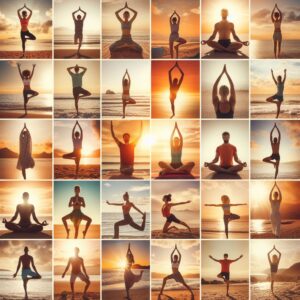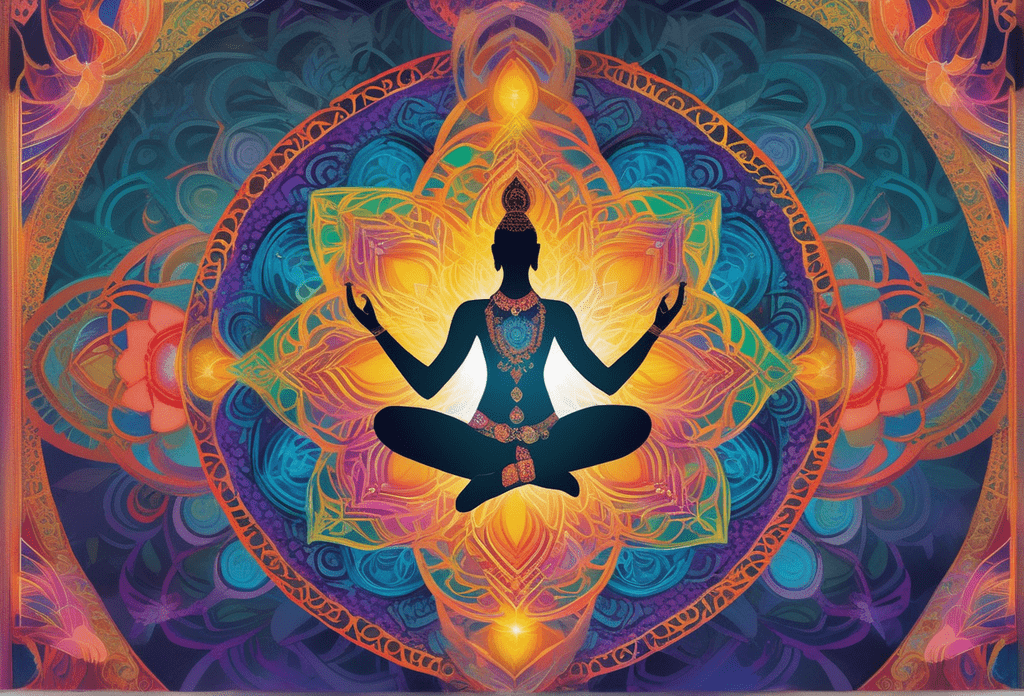Yoga originated in ancient India and has evolved into a diverse practice worldwide. It encompasses physical postures, breathing exercises, meditation, and ethical principles. Over time, Yoga has diversified into various styles influenced by different cultures, schools of thought, and individual interpretations. Popular styles include Hatha, Ashtanga, Vinyasa, Kundalini, and Iyengar Yoga.
Cultural influences have led to the development of styles like Power and Hot Yoga in the West, while in India, Yoga remains connected to traditional roots. Philosophical schools such as Patanjali’s Yoga Sutras, Advaita Vedanta, and Tantra have contributed to the diversity of Yoga. Each practitioner brings their unique interpretation, leading to various approaches and variations within each style. The diverse tapestry of yoga styles and practices across the globe is a testament to its rich and dynamic nature.
Yoga styles from India

Hatha Yoga: The foundation for most modern styles, focusing on physical postures (asana) and breath control (pranayama). Hatha Yoga is a type of Yoga that serves as the basis for many of the yoga styles practiced today. It emphasizes physical postures, also known as asanas, which involve various body positions and movements. These postures are combined with control techniques, known as pranayama, which include regulating and manipulating the breath. Hatha Yoga aims to bring balance and harmony to the body and mind by integrating physical movements with breath control.
Ashtanga Yoga: A dynamic and vigorous practice with a set sequence of postures. Ashtanga Yoga is a more intense and physically demanding style of Yoga. It follows a specific sequence of postures that are performed in a flowing and continuous manner. Ashtanga Yoga involves synchronizing breath with movement, creating a dynamic and vigorous practice. This style of Yoga is known for its challenging nature and is often practiced by individuals looking for a more physically demanding workout.
Iyengar Yoga: Emphasizes precise alignment and the use of props to facilitate deeper poses. Iyengar Yoga is a style that strongly emphasizes the accurate alignment of the body in each posture. It focuses on achieving proper alignment to ensure maximum benefits and minimize the risk of injury. Props such as blocks, straps, and blankets are often used in Iyengar Yoga to assist practitioners in achieving correct alignment and to facilitate deeper stretches. This style of Yoga is suitable for individuals of all levels, including beginners, as it allows for modifications and adjustments to accommodate different body types and abilities.
Vinyasa Yoga: A fluid and creative yoga style linking breath with movement. Vinyasa Yoga is a dynamic and flowing style emphasizing breath and movement connection. It smoothly transitions from one posture to another, synchronized with the breath. Vinyasa Yoga is often described as a moving meditation, as the continuous flow of movement and breath helps cultivate a sense of mindfulness and presence. This style of Yoga offers a creative and varied practice, as sequences can be tailored to suit different levels and intentions.
Yin Yoga: A meditative practice of holding passive poses for extended periods. Yin Yoga is a slower-paced and more meditative yoga style. It involves holding passive poses for an extended period, typically 3 to 5 minutes or even longer. Yin Yoga focuses on relaxing the muscles and targeting the deeper connective tissues, such as ligaments and fascia. This practice helps to improve flexibility, increase circulation, and cultivate a sense of calm and introspection.
Kundalini Yoga: Incorporates chanting, kriyas (repetitive movements), and meditation to activate energy pathways. Kundalini Yoga is a spiritual and energetic yoga style that aims to awaken and activate the dormant energy within the body. It incorporates various practices such as chanting, repetitive movements called kriyas, and meditation.
Chanting involves the repetition of specific mantras or sacred sounds, which are believed to have a transformative effect on the mind and body. Kriyas are particular sequences of movements, breathwork, and chanting designed to stimulate and balance the energy centers in the body. Kundalini Yoga is believed to help release blocked energy, promote spiritual growth, and enhance overall well-being.
From the West
Power Yoga: Inspired by Ashtanga, emphasizing strength, flexibility, and cardiovascular conditioning. Power Yoga is a style influenced by Ashtanga yoga, a traditional form of Yoga that focuses on synchronizing breath with a series of postures.
Power Yoga places a greater emphasis on building strength, improving flexibility, and enhancing cardiovascular fitness.
This yoga style typically involves dynamic and flowing movements, often incorporating challenging poses and sequences. Power Yoga classes are usually physically demanding and can be a good option for individuals looking for a more intense workout while benefiting from the mind-body connection Yoga offers.
Bikram Yoga: Practiced in a heated room, promoting intense sweating and detoxification. Bikram Yoga is a specific yoga style practiced in a room heated to around 105 degrees Fahrenheit with a humidity of 40%. This style of Yoga consists of a series of 26 postures and two breathing exercises performed in a specific sequence.
The heat in the room is believed to promote intense sweating, which is thought to help detoxify the body by flushing out toxins through the skin. The high temperature also helps warm the muscles and increase flexibility, allowing deeper stretches and poses. Bikram Yoga is known for its physically demanding nature and can be challenging for beginners or individuals not accustomed to exercising in a heated environment.
Anusara Yoga: A heart-centered practice emphasizing alignment and positive affirmations. Anusara Yoga is a style that focuses on the heart-centered approach to practice, emphasizing alignment and positive affirmations.
This style of Yoga encourages practitioners to connect with their hearts and cultivate a sense of joy and gratitude. Anusara Yoga strongly emphasizes proper alignment in poses, with the belief that alignment not only helps prevent injuries but also allows for a deeper connection to the body and a more fulfilling practice. Positive affirmations, such as repeating uplifting phrases or mantras, are often incorporated into Anusara Yoga classes to promote a positive mindset and enhance the overall experience.
Restorative Yoga: Uses props to support the body in restful poses for relaxation and healing. Restorative Yoga is a gentle, relaxing yoga style that focuses on restful poses and deep relaxation. This style of Yoga uses various props, such as blankets, bolsters, and blocks, to support the body in comfortable and vital positions. The props help create a sense of ease and comfort, allowing the body to relax and release tension. Restorative Yoga is particularly beneficial for individuals looking to reduce stress, promote relaxation, and support healing and recovery from injuries or illnesses.
The slow and gentle nature of Restorative Yoga makes it suitable for all levels, including beginners and individuals with limited mobility.
AcroYoga: Combines yoga postures with acrobatics and partner work.AcroYoga is a unique yoga style that combines traditional yoga postures with acrobatics and partner work. This style of Yoga involves two or more people working together to create dynamic and acrobatic sequences.AcroYoga often includes balance, strength, and trust as partners support each other in various poses and movements. This style of Yoga can be a fun and playful way to build strength, improve flexibility, and enhance communication and connection with others.
AcroYoga is typically practiced in a safe and supportive environment, with spotters or instructors providing guidance and assistance to ensure the safety of all participants.
Global Fusion
Yoga Therapy: Integrates yoga principles and practices into therapeutic settings for various ailments. Yoga therapy is a specialized form of therapy that incorporates the principles and practices of Yoga into therapeutic settings. It is used to address a wide range of physical, mental, and emotional ailments. Integrating Yoga into therapy allows individuals to benefit from the physical movements, breathing exercises, and meditation techniques inherent in Yoga. Yoga therapy is often used as a complementary treatment alongside traditional medical interventions. It focuses on the individual’s needs and aims to promote overall well-being and healing.
Pranayama Yoga: Focuses solely on breath control and its various techniques. Pranayama yoga is a specific branch of Yoga that emphasizes breath control and its various techniques. It involves conscious manipulation of the breath to achieve clear physical, mental, and spiritual benefits. Practicing pranayama involves different breathing exercises, such as deep breathing, alternate nostril breathing, and breath retention. These techniques help to regulate and balance the flow of prana (life force energy) in the body. Pranayama yoga enhances vitality, improves concentration, reduces stress, and promotes overall well-being.
Meditation Yoga: Different meditation techniques are combined with yoga poses for a holistic practice. Meditation yoga combines the practice of meditation with traditional yoga poses to create a holistic practice. It involves incorporating various meditation techniques, such as mindfulness, loving-kindness, or transcendental meditation, into the yoga practice. Combining meditation and yoga helps cultivate a more profound sense of awareness, relaxation, and inner peace. Meditation yoga can be practiced by individuals of all levels, from beginners to advanced practitioners.
It offers numerous benefits, including stress reduction, improved mental clarity, increased self-awareness, and greater well-being.
Aerial Yoga: Uses hammocks to support the body in various poses, promoting flexibility and decompression. Aerial Yoga is a unique form that utilizes hammocks or fabric slings to help the body in multiple poses.
The hammocks are suspended from the ceiling, allowing practitioners to explore yoga poses in a broken and weightless state. This form of Yoga promotes flexibility, as the hammocks provide support and allow for deeper stretches. It also helps to decompress the spine and joints, as the body is suspended and relieved from the effects of gravity. Aerial Yoga can be a fun and challenging practice that offers a unique way to experience Yoga and improve strength, flexibility, and body awareness.
SUP Yoga: Practiced on stand-up paddleboards, adding a balance challenge and connection with nature.SUP yoga, also known as stand-up paddleboard yoga, is a form of Yoga practiced on a stand-up paddleboard in water.
It combines the physical movements and poses of Yoga with the challenge of maintaining balance on the unstable surface of the paddleboard.SUP yoga offers a unique and immersive experience, as practitioners are surrounded by nature and the calming effects of water. The practice of SUP yoga requires core strength, stability, and focus, as the paddleboard constantly moves with the water. It provides an opportunity to connect with nature, improve balance, build strength, and enhance mindfulness.
Conclusion
It’s important to remember that Yoga goes beyond specific styles. Underlying all these variations are the core principles of Yoga: self-discipline, non-violence, truthfulness, non-stealing, contentment, cleanliness, austerity, study, and self-surrender. These principles guide practitioners toward a life of inner peace, harmony, and self-realization. This is just a brief overview of the diverse world of Yoga. The best way to discover the style that resonates with you is to explore and experiment. Take classes, attend workshops, and connect with different teachers. Let curiosity and an open mind guide you on your yoga journey.




1 thought on “Discover the Secret World of Yoga”